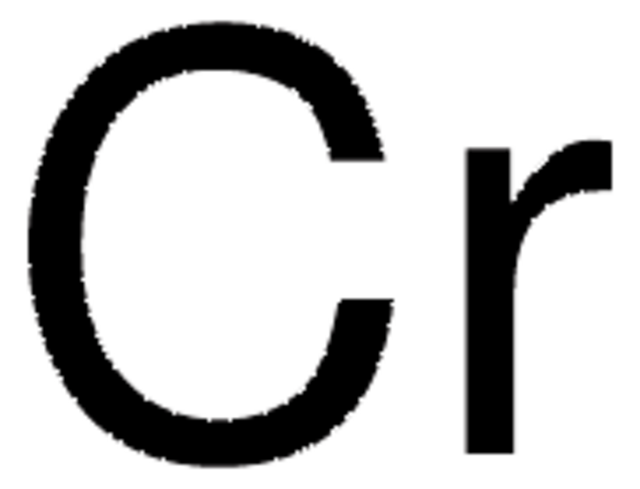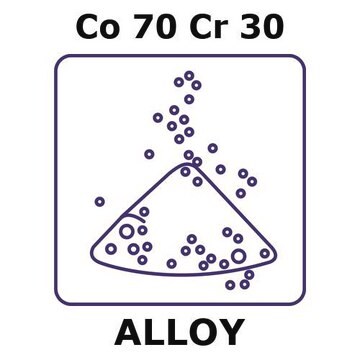Wszystkie zdjęcia(2)
Kluczowe dokumenty
266299
Chromium
powder, ≥99% trace metals basis, <45 μm
Synonim(y):
Cd
Zaloguj sięWyświetlanie cen organizacyjnych i kontraktowych
About This Item
Wzór empiryczny (zapis Hilla):
Cr
Numer CAS:
Masa cząsteczkowa:
52.00
Numer WE:
Numer MDL:
Kod UNSPSC:
12161600
Identyfikator substancji w PubChem:
NACRES:
NA.22
Polecane produkty
Poziom jakości
Próba
≥99% trace metals basis
Postać
powder
przydatność reakcji
core: chromium
reagent type: catalyst
rezystywność
12.7 μΩ-cm, 20°C
wielkość cząstki
<45 μm
tw
2672 °C (lit.)
mp
1857 °C (lit.)
gęstość
7.14 g/mL at 25 °C (lit.)
ciąg SMILES
[Cr]
InChI
1S/Cr
Klucz InChI
VYZAMTAEIAYCRO-UHFFFAOYSA-N
Szukasz podobnych produktów? Odwiedź Przewodnik dotyczący porównywania produktów
Powiązane kategorie
Opis ogólny
Chromium is widely used as a catalyst in chemical synthesis. It is also used in the preparation of other chromium-based compounds.
Zastosowanie
Chromium (Cr) powder can be used in the preparation of Cr-based nanoporous metal-organic frameworks in activated carbon. This composite is used as an adsorbent for the removal of contaminants of emerging concern (CECs) from water.
Ta strona może zawierać tekst przetłumaczony maszynowo.
Kod klasy składowania
11 - Combustible Solids
Klasa zagrożenia wodnego (WGK)
nwg
Temperatura zapłonu (°F)
Not applicable
Temperatura zapłonu (°C)
Not applicable
Środki ochrony indywidualnej
Eyeshields, Gloves, type N95 (US)
Wybierz jedną z najnowszych wersji:
Masz już ten produkt?
Dokumenty związane z niedawno zakupionymi produktami zostały zamieszczone w Bibliotece dokumentów.
Klienci oglądali również te produkty
J A J Vanoirbeek et al.
Journal of toxicology and environmental health. Part A, 66(4), 393-409 (2003-01-30)
Chromium-based catalysts are used for the synthesis of polyethylene, but little is known about the hazard and biomonitoring possibilities of this type of chromium for workers who may be occupationally exposed to such compounds. Therefore, the bioavailability and toxicokinetics of
B Seifert et al.
Journal of exposure analysis and environmental epidemiology, 10(2), 103-114 (2000-05-03)
The German Environmental Survey (GerES) is a large-scale population study which has repeatedly been carried out in Germany. GerES I was conducted in 1985/1986 followed by GerES IIa in 1990/1991 (West Germany) and GerES IIb in 1991/1992 (East Germany). GerES
Feng Liu et al.
Scientific reports, 3, 1554-1554 (2013-03-28)
In conventional photostimulable storage phosphors, the optical information written by x-ray or ultraviolet irradiation is usually read out as a visible photostimulated luminescence (PSL) signal under the stimulation of a low-energy light with appropriate wavelength. Unlike the transient PSL, here
A J Hart et al.
The Journal of bone and joint surgery. American volume, 95(8), 678-685 (2013-04-19)
Determining the relationship between clinical factors and engineering analysis of retrieved hip implants can help our understanding of the mechanism of device failure. This is particularly important for metal-on-metal hip arthroplasties because the most common cause of failure is unexplained.
Carola Lidén et al.
Contact dermatitis, 54(5), 233-238 (2006-05-13)
There is a great need to accurately assess skin exposure to contact allergens. We have developed a technique for assessment of skin exposure to nickel, chromium and cobalt using acid wipe sampling by cellulose wipes with 1% nitric acid. Chemical
Nasz zespół naukowców ma doświadczenie we wszystkich obszarach badań, w tym w naukach przyrodniczych, materiałoznawstwie, syntezie chemicznej, chromatografii, analityce i wielu innych dziedzinach.
Skontaktuj się z zespołem ds. pomocy technicznej





